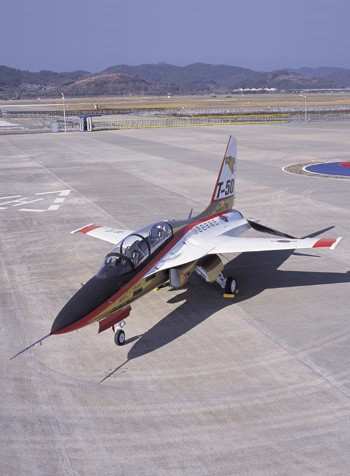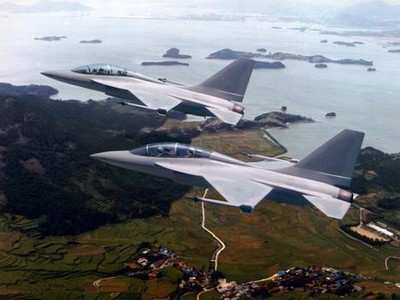Thu, Jul 15, 2004
Korean Supersonic Trainer Put Through The Wringer
The Republic of Korea Air Force (ROKAF) recently began high
angle-of-attack (AOA) flight testing on the T-50 Golden Eagle, a
supersonic jet trainer being developed by Korea Aerospace
Industries (KAI) with technical assistance from Lockheed
Martin.

"It is imperative that we build an advanced jet trainer that is
safe for our student pilots to fly," said Lt. Col. Lee,
Choong-Whan, the senior ROKAF T-50 test pilot. "Although the design
engineers have excellent design tools and simulation capabilities,
our job in the test force is to wring the aircraft out, looking for
any anomalies. It is important that we fully understand the high
AOA characteristics of this aircraft before it is placed in the
training command."
The initial high AOA flight testing will use the basic
air-to-air loadings and include planned departures from controlled
flight. These departures result from climbing the aircraft at low
power setting until it runs out of airspeed with the pilot applying
aggressive control inputs. Once the aircraft is departed,
recoverability will be tested. These maneuvers will demonstrate the
ability to recover to normal flight within all operational weights
and possible centers of gravity of the airplane.
The T-50 has an advanced digital electronic flight control
system that is designed to be highly departure-free during normal
operations and aids in recovery from any out-of-control situation.
The AOA limiter in the flight control system is set at 25 degrees
AOA. High angle-of-attack testing is needed to verify predicted AOA
stall and departure limits, aircraft departure characteristics when
these limits are exceeded, and the flight control system's
effectiveness in both prevention and recovery of departures from
controlled flight.

Testing will be conducted at the Korean flight test facility at
Sachon Air Base, Republic of Korea, using the second of four test
aircraft. As a safety measure, an external spin recovery parachute
assembly has been mounted on the aircraft for use in the event the
aircraft cannot be recovered normally.
Approximately 47 flights over a four-month period will be
required to complete this phase of testing. Full training loadings
and air-to-surface loadings will be tested in subsequent series of
high AOA testing.
The T-50 flight test program continues to progress
satisfactorily and recently surpassed 400 sorties. The first flight
test aircraft has completed more than 200 sorties.
More News
Terminal Radar Service Area Airspace surrounding designated airports wherein ATC provides radar vectoring, sequencing, and separation on a full-time basis for all IFR and participa>[...]
Aero Linx: Utah Back Country Pilots Association (UBCP) Through the sharing experiences, the UBCP has built upon a foundation of safe operating practices in some of the most challen>[...]
From 2010 (YouTube Edition): Imagine... Be The Change... Inspire FROM 2010: One of the more unusual phone calls I have ever received occurred a few years ago... from Anousheh Ansar>[...]
(Pilot) Felt A Shudder And Heard The Engine Sounding Differently, Followed By The Engine Chip Detector Light On April 14, 2025, about 1800 Pacific daylight time, a Bell 206B, N1667>[...]
Also: AMA Names Tyler Dobbs, More Falcon 9 Ops, Firefly Launch Unsuccessful, Autonomous F-16s The Air Force has begun ground testing a future uncrewed jet design in a milestone tow>[...]
 ANN's Daily Aero-Term (05.07.25): Terminal Radar Service Area
ANN's Daily Aero-Term (05.07.25): Terminal Radar Service Area ANN's Daily Aero-Linx (05.07.25)
ANN's Daily Aero-Linx (05.07.25) Classic Aero-TV: Anousheh Ansari -- The Woman Behind The Prize
Classic Aero-TV: Anousheh Ansari -- The Woman Behind The Prize NTSB Prelim: Bell 206B
NTSB Prelim: Bell 206B Airborne-NextGen 05.06.25: AF Uncrewed Fighters, Drones v Planes, Joby Crew Test
Airborne-NextGen 05.06.25: AF Uncrewed Fighters, Drones v Planes, Joby Crew Test




